Physical Address
304 North Cardinal St.
Dorchester Center, MA 02124
Nodules and tumors in the skin often raise fears of skin cancer. Fortunately, primary skin cancer is extremely rare in childhood, and most infiltrated plaques and tumors are benign ( Table 5.1 ). Hemangiomas, congenital nevi, and tumors of the newborn are reviewed in Chapter 2 , while pigmented nevi and melanomas are discussed in Chapter 6 . The focus in this chapter is disorders of childhood and adolescence.
| Type | n | (%) |
|---|---|---|
| Epidermal inclusion cysts | 459 | 59 |
| Congenital malformations (pilomatrixoma, lymphangioma, brachial cleft cyst) | 117 | 15 |
| Benign neoplasms (neural tumors, lipoma, adnexal tumors) | 56 | 7 |
| Benign lesions of undetermined origin (xanthomas, xanthogranulomas, fibromatosis, fibroma) | 50 | 6 |
| Self-limited processes (granuloma annulare, urticaria pigmentosa, insect-bite reaction) | 47 | 6 |
| Malignant tumors | 11 | 1.4 |
| Miscellaneous | 35 | 4 |
Several clinical clues, including the depth and color of lesions, aid in developing a differential diagnosis. Superficial growths are readily moved back and forth over the underlying dermis, whereas the overlying epidermis and superficial dermis may slide over deep-seated tumors. Some dermal and subcutaneous lesions characteristically produce tethering of the overlying skin. Epidermal tumors include warts, molluscum, and seborrheic keratoses. Milia, neurofibromas, granuloma annulare, mastocytomas, scars, keloids, xanthomas, xanthogranulomas, melanocytic nevi, and adnexal tumors involve the superficial and mid-dermis. Leukemia, lymphoma, melanoma, lipomas, and metastatic solid tumors involve the dermis and/or fat and may extend deep into subcutaneous structures.
Color may suggest the specific cell types that comprise various cutaneous nodules and tumors. For instance, yellow tumors might include large quantities of fat in a lipoma or lipid-laden histiocytes in xanthomas or xanthogranulomas. Melanocytic nevi, epidermal nevi, mastocytomas, and seborrheic keratosis contain varying amounts of the brown pigment melanin in melanocytes or keratinocytes. Vascular tumors are usually red or blue, and primary or metastatic nodules may appear in various shades of red, purple, and blue, depending on their depth and degree of vascularity.
Finally, the diagnosis of certain genodermatoses associated with cutaneous and/or internal malignancies allows the clinician to develop strategies for close monitoring. Early recognition of malignancy in this setting may be life-saving ( Table 5.2 ). An algorithmic approach to diagnosis for nodules and tumors is summarized at the end of the chapter ( Fig. 5.39 ).
| Disease | Associated Cancer | Clinical Manifestations | Genetics |
|---|---|---|---|
| Basal cell nevus syndrome (Gorlin syndrome) | Many basal cell carcinomas (mean age of onset 15 years) on sun-exposed and non-sun-exposed areas; medulloblastoma; astrocytoma | Many basal cell nevi, palmar and plantar pits, jaw cysts, calcification of the falx cerebri, ovarian fibromas, fused ribs | Autosomal dominant; PTCH1 gene on chromosome 9q22.32 |
| Hidrotic ectodermal dysplasia (Clouston syndrome) | Squamous cell carcinoma of palms, soles, nail bed | Normal sweating, total alopecia, severe nail dystrophy, palmar and plantar hyperkeratosis | Autosomal-dominant GJB6 gene |
| Acrokeratosis paraneoplastica (Bazex syndrome) | Basal cell carcinomas of the face (second to third decade) | Follicular atrophoderma, localized anhidrosis, and/or generalized hypohidrosis | Autosomal-dominant Xq24–q27 |
| Dysplastic nevus syndrome (familial, atypical, multiple-mole syndrome) | Cutaneous and intraocular melanoma, lymphoreticular malignancy, sarcomas | Multiple, large reddish-brown moles with irregular borders and non-uniform colors, usually on trunk and arms; familial occurrence of melanoma | Autosomal-dominant genetic heterogeneity |
| PTEN hamartoma tumor syndrome (formerly Cowden disease) | Carcinoma of the breast, colon, thyroid | Storiform collagenoma. Coexistence of multiple, ectodermal, mesodermal, and endodermal nevoid neoplasms; punctate keratoderma of the palms; multiple angiomas, lipomas | Autosomal dominant; PTEN gene on chromosome 10q23.31 |
| Neurofibromatosis type 1 (von Recklinghausen disease) |
|
|
Autosomal-dominant NF1 gene Sporadic mutations in 50% of cases |
| Neurofibromatosis type 2 |
|
|
|
| Multiple mucosal neuroma syndrome (multiple endocrine neoplasia type IIB) | Pheochromocytoma, medullary thyroid carcinoma | Pedunculated nodules on eyelid margins, lip; tongue with true neuromas | Autosomal dominant; gene locus 10q11.2; sporadic mutation in 50% RET gene |
| Intestinal polyposis II (Peutz–Jeghers syndrome) | Adenocarcinoma of the colon, duodenum; granulosa cell ovarian tumors | Pigmented macules on oral mucosa, lips, conjunctivae, digits; intestinal polyps | Autosomal dominant; STK11/LKB1 gene on chromosome 19p13.3; sporadic mutation in 40% |
| Intestinal polyposis III (Gardner syndrome) | Malignant degeneration of colon, adenomatous polyps; sarcomas, thyroid carcinoma | Polyps of the colon, small intestine; globoid osteoma of mandible with overlying fibromas; epidermoid cysts; desmoids | 5q21–q22 APC gene |
| Tuberous sclerosis | Rhabdomyoma of myocardium, gliomas, mixed tumor of kidney | Triad of angiofibromas, epilepsy, intellectual delay; ash-leaf macules; shagreen patches; subungual fibromas; intracranial calcification in 50% | Spontaneous mutation in 75%; autosomal dominant in 25%; heterogeneous loci, 9q34 ( TSC1 ), 16p13 ( TSC2 ) |
| Epidermolysis bullosa dystrophica dominant | Squamous cell carcinoma in chronic lesions | Lifelong history of bullae; phenotype not as severe as in recessive forms | Autosomal recessive, chromosome 3p21 (collagen type VII gene) |
| Epidermolysis bullosa dystrophica recessive | Basal, squamous cell carcinoma in skin, mucous membranes (especially esophagus) | Bullae develop at sites of trauma; present at birth or early infancy; may involve mucous membranes, esophagus, conjunctivae, cornea | Autosomal recessive, chromosome 3p (collagen type VII gene) |
| Albinism | Increased incidence of cutaneous malignancies | Lack skin pigment, incomplete hypopigmentation of ocular fundi, horizontal congenital nystagmus, myopia |
|
| Congenital telangiectasia erythema (Bloom syndrome) | High incidence of leukemia, lymphoma; squamous cell cancers of esophagus; adenocarcinoma of colon, often by 20 years of age | Small stature; cutaneous photosensitivity presenting as telangiectatic, facial (malar) erythema | Autosomal recessive; gene locus 15q26.1 RECQL3 gene |
| Chédiak–Higashi syndrome | Malignant lymphoma | Decreased pigmentation of hair, eyes; photophobia; nystagmus; abnormal susceptibility to infection | Autosomal recessive CHS1 gene |
| Poikiloderma congenitale (Rothmund–Thomson syndrome) |
|
Poikiloderma, short stature, cataracts, photosensitivity, nail defects, alopecia, bony defects | Autosomal recessive; gene locus 8q24.3 RECQL4 gene |
| Xeroderma pigmentosum | Basal and squamous cell carcinoma of skin, malignant melanoma | Marked photosensitivity, early freckling, telangiectasia, keratoses, papillomas, photophobia, keratitis, corneal opacities |
|
| Wiskott–Aldrich syndrome (eczema thrombocytopenia-immunodeficiency syndrome) | Lymphoreticular malignancies, malignant lymphoma, myelogenous leukemia, astrocytoma | Eczema, thrombocytopenia, bleeding problems (i.e. melena, purpura, epistaxis), increased susceptibility to skin infections, otitis, pneumonia, meningitis | X-linked recessive; gene locus Xp11.2–11.3 WAS gene |
| Dyskeratosis congenita | Squamous cell carcinoma of oral cavity, esophagus, nasopharynx, skin, anus | Reticulated hypo- and hyperpigmentation of skin, nail dystrophy, leukoplakia of oral mucosa, thrombocytopenia, testicular atrophy | X-linked recessive (most common); gene locus Xq28 DKCI gene |
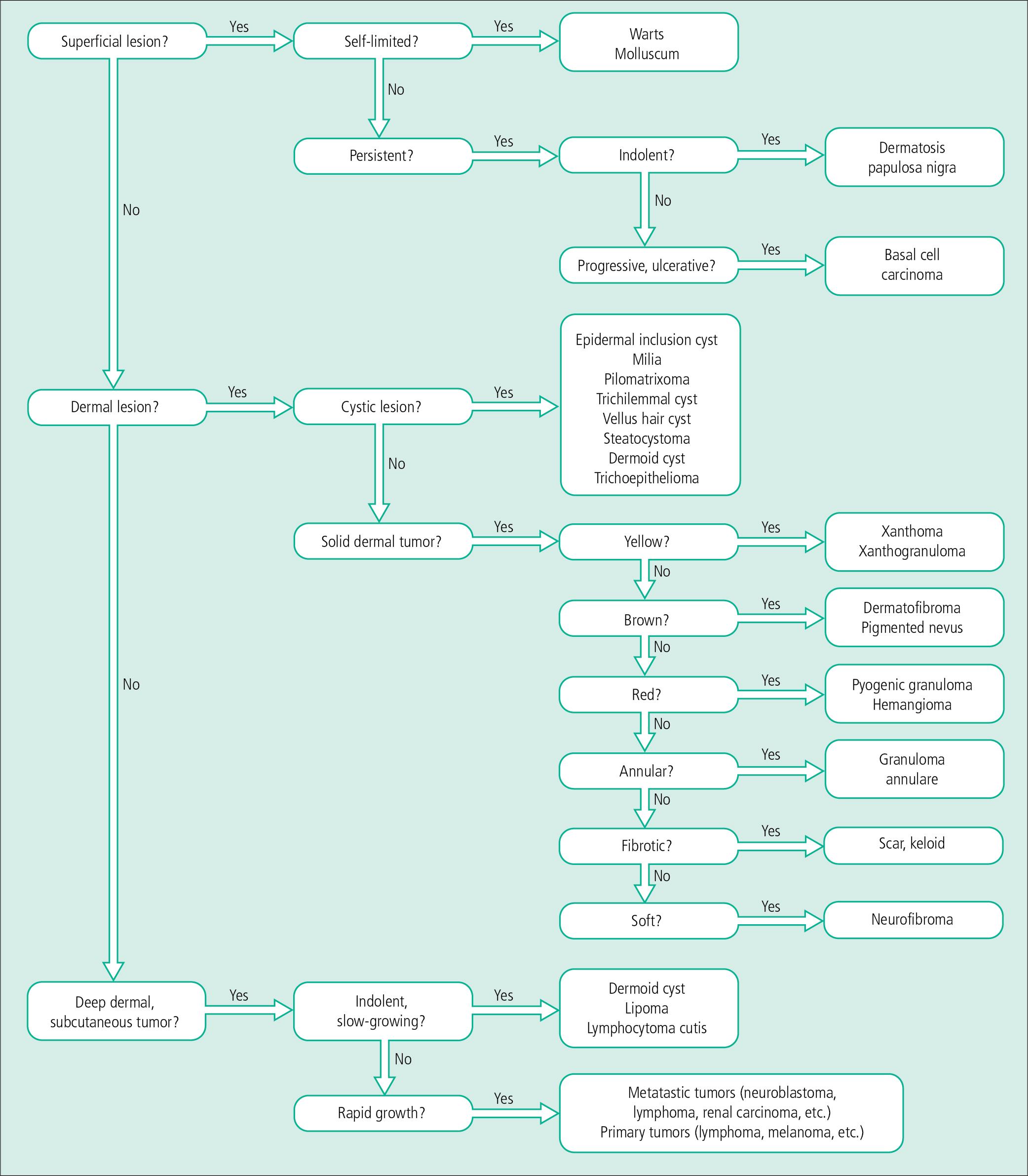
Warts are benign epidermal tumors produced by human papillomavirus (HPV) infection of the skin and mucous membranes. In children they are seen most commonly on the fingers, hands, and feet. The face and lips are often involved. However, they can infect any area on the skin or mucous membranes ( Fig. 5.1–Fig. 5.8 ). The incubation period for warts varies from 1 to 3 months and possibly up to several years, and the majority of lesions disappear within 3–5 years. Local trauma promotes inoculation of the virus. Thus, periungual warts are common in children who bite their nails or pick at hangnails ( Fig. 5.3 ), which may lead to oral inoculation as well.

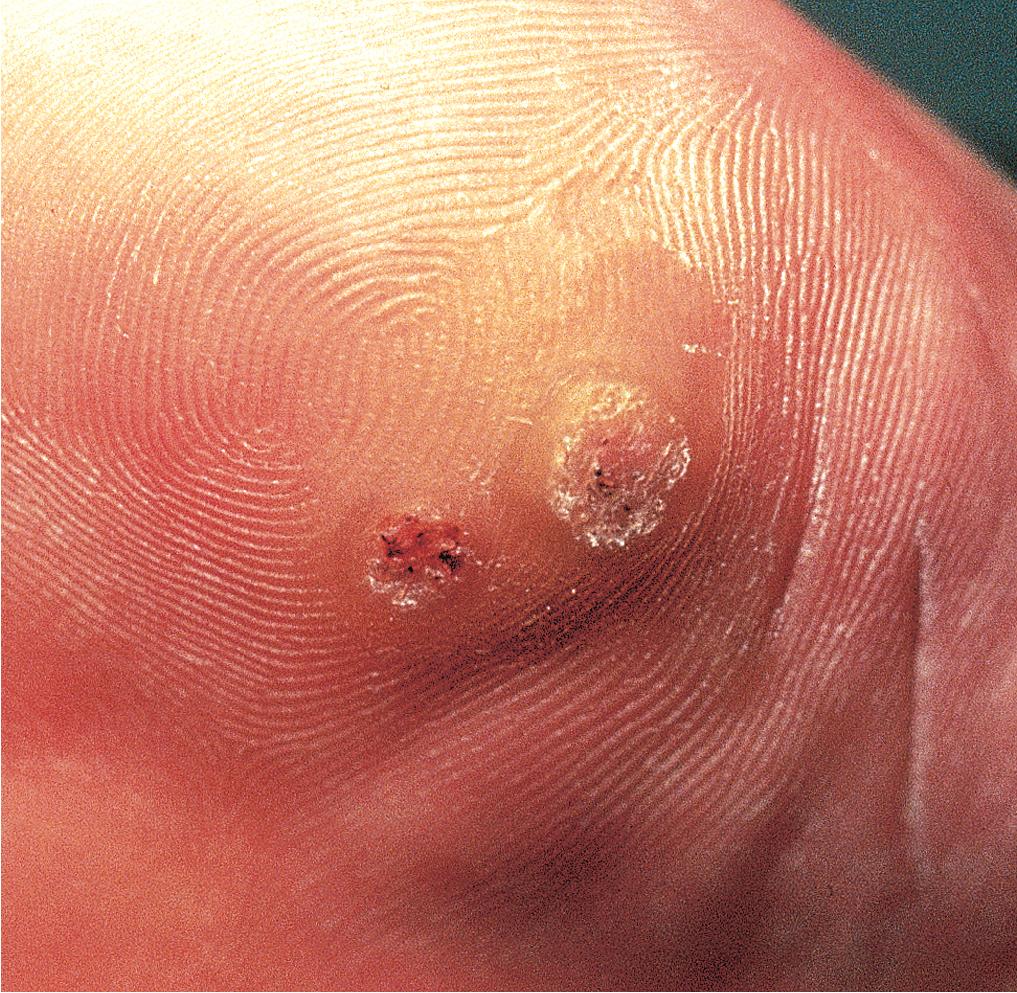
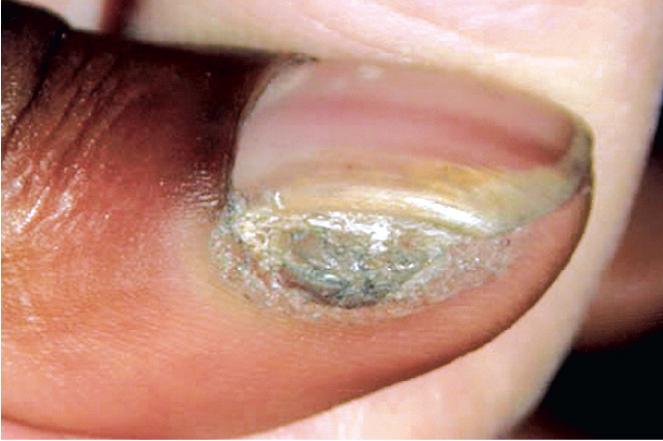
Investigators have identified over 100 HPV types capable of producing warts, and many of these strains produce characteristic lesions in specific locations. For instance, the discrete, round, skin-colored papillomatous papules typical of verruca vulgaris (common warts) are produced by HPV-1, HPV-2, and HPV-4 ( Figs. 5.1 and 5.4 ). The subtle, minimally hypo- or hyperpigmented flat warts (verruca plana), which are caused by HPV-3 and HPV-10, are frequently spread by deliberate or accidental scratching, shaving, or picking and may become widespread on the face, arms, and legs ( Fig. 5.5 ).
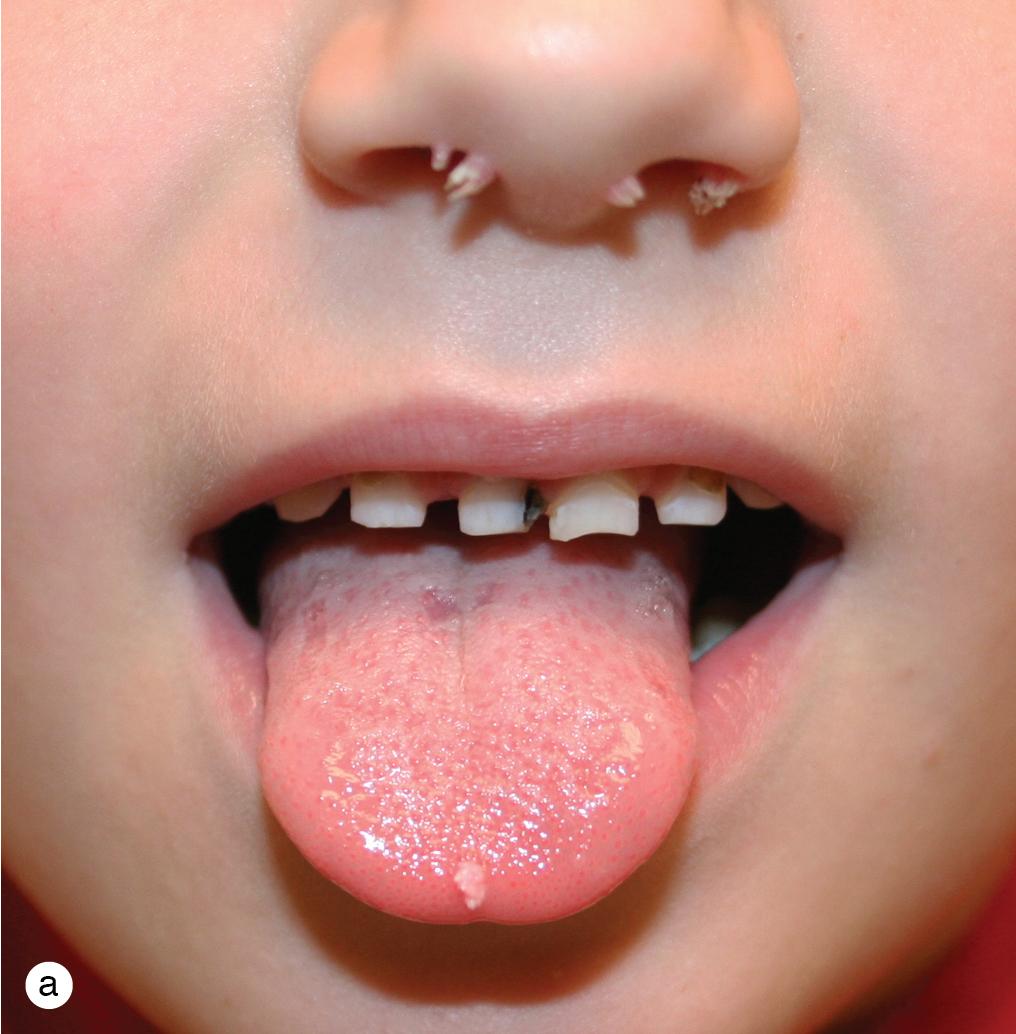
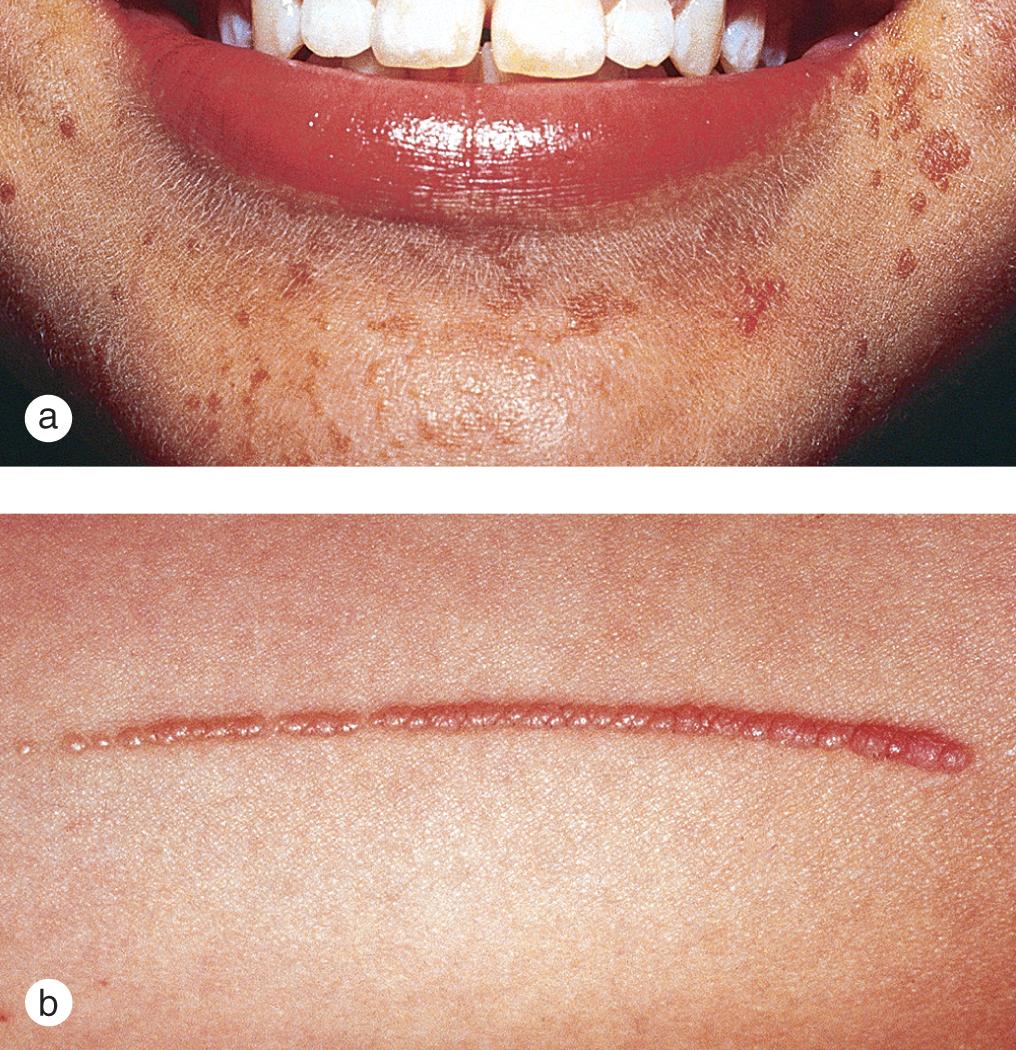
Plantar warts are most commonly caused by HPV-1 ( Fig. 5.2 ). Although not proved, the transmission of these warts probably occurs by contact with contaminated, desquamated skin in showers, pool decks, and bathrooms. Although often subtle on the surface, their large size may be hidden by a collarette of skin of normal appearance, and the overlying or surrounding calluses often cause pain when the patient walks. Although plantar warts may be confused with corns, calluses, or scars, they can be differentiated by their disruption of the normal dermatoglyphics. Characteristic black dots in the warts are thrombosed capillaries.
Warts can also be found on the trunk, oral mucosa, and conjunctivae. Condyloma acuminatum and flat warts in the anogenital area are usually caused by non-carcinogenic HPV-6 and HPV-11 ( Fig. 5.6 ). However, a number of HPV types including 16 and 18 have been associated with cervical carcinoma and oropharyngeal carcinoma. The 9-valent HPV vaccine (9vHPV) (Gardasil-9) is U.S. Food and Drug Administration (FDA)-approved for patients aged 9–45 (expanded in October 2018 to include patients aged 27–45) and protects against oncogenic HPV types 16, 18, 31, 33, 45, 52, and 58 and non-oncogenic types 6 and 11 that cause genital warts. The quadrivalent (Gardasil) vaccine (HPV types 6, 11, 16, 18) and bivalent (Cervarix) vaccine (HPV types 6, 11) are approved for patients aged 9–26 years and females aged 9–25, respectively. These vaccinations may prove to be a useful treatment for common warts. In a 2019 prospective study by Nofal et al. of 44 adult patients with multiple recalcitrant common warts, the bivalent HPV vaccine administered intramuscularly either as per the FDA-approved protocol (0, 1, 6 months) or until clearance, or intralesionally to the largest wart in 2-week intervals, led to complete resolution in 63.3% and 81.8% of the patients, respectively. The benefit for treating common warts caused by strains not formulated in those specific vaccines is thought to arise from cross-reaction of the viral capsid proteins.

Anogenital warts may be found in children and always raises the question of sexual abuse. However, in young children, most anogenital warts are transmitted in a non-venereal fashion. This includes vertical transmission before and during pregnancy or delivery and horizontal transmission via heteroinoculation by direct contact with affected parents or caretakers with common warts, as well as autoinoculation of common warts from hands to the anogenital region, with a latency period of 2–3 years leading to a delayed presentation. Some authors note increased concern for sexual abuse in children greater than 4 years of age. However, there is no established absolute age-cut off. Suspicion for abuse increases with age and with consideration to the patient’s social history and presence of sexually transmitted diseases (including herpes simplex, gonorrhea, chlamydia, syphilis, or human immunodeficiency virus). HPV genotyping has not proven to be a reliable method for determining mode of transmission and is not widely utilized in the context of evaluation for sexual abuse. In addition, there are no clear malignancy screening guidelines in pediatric patients with anogenital warts. Warts are self-limited in most children, but persistent, widespread lesions suggest the possibility of congenital or acquired immunodeficiency ( Fig. 5.7 ). In fact, warts may become a serious management problem in oncology and transplant patients who are chronically immunosuppressed.
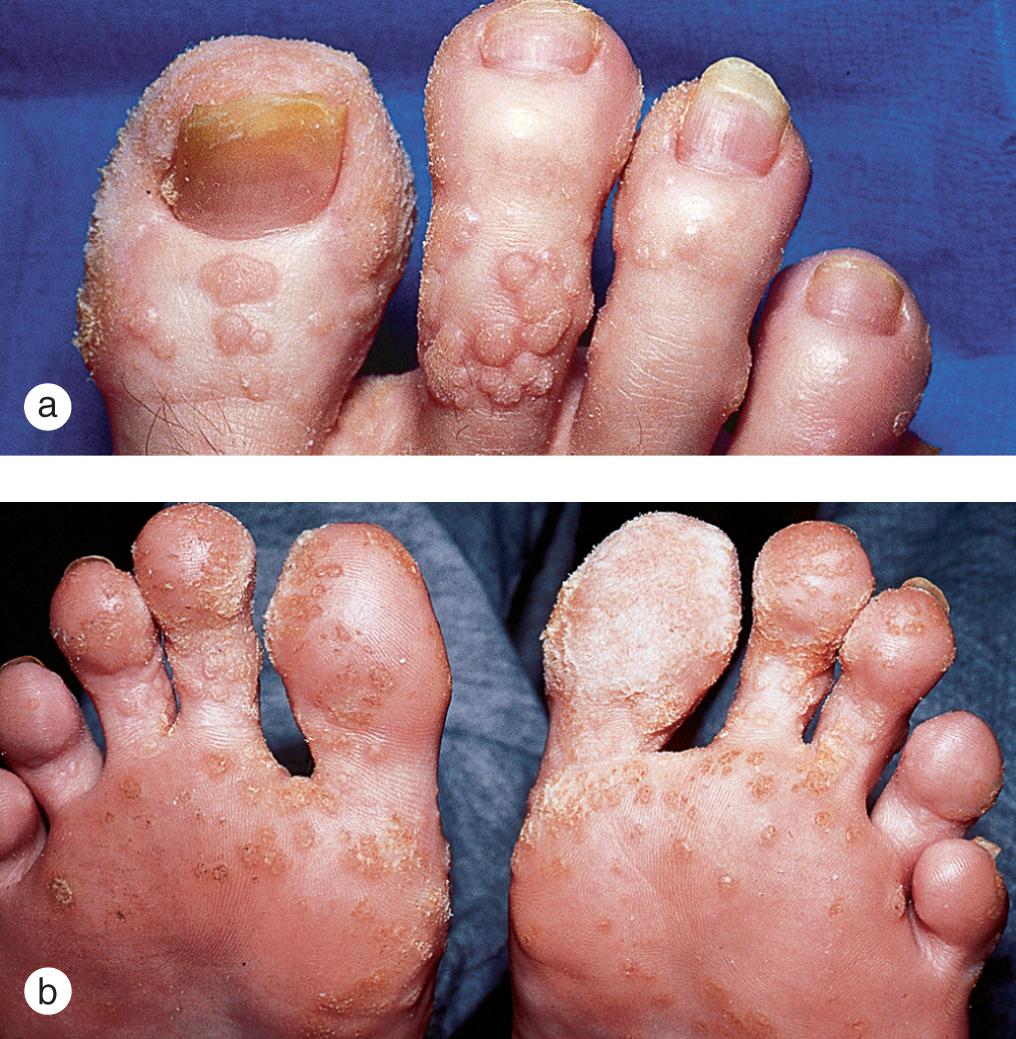
Topical keratolytics, which work essentially by peeling off thickened skin from warts and callosities, include salicylic acid (SA) and lactic acid in occlusive vehicles such as collodion or under tape occlusion. These are safe, effective, and relatively painless preparations with which to treat warts that are not in sensitive areas such as the eyelids and perineum.
Recalcitrant lesions may respond to destructive measures, which include liquid nitrogen, electrocautery, and carbon dioxide laser surgery. Pulsed-dye laser is also used in recalcitrant cases and may exert its effect gradually over time via destruction of the blood supply to the wart, as well as heat destruction of the tissue and induction of immunity. However, patients and parents must be cautioned about the risk of recurrence and scarring with destructive methods ( Figs. 5.8 and 5.9 ). Cryotherapy is used most commonly in general practice. There is limited positive evidence regarding the efficacy of either SA or cryotherapy compared with placebo. There is also limited positive evidence for the efficacy of cryotherapy compared with placebo or SA on the hands and in combination with SA versus SA alone. Cantharidin, both alone and in combination with podophyllotoxin and SA for plantar warts, may be beneficial but also has a risk of blistering, pain, dyspigmentation, and even scarring. Topical imiquimod and topical fluorouracil are sometimes used in recalcitrant cases, though sufficient evidence is lacking. Candida antigen injections are also safe and effective wart treatments for some patients in whom it induces an “immunity” to HPV with side effects including pruritus, erythema, oozing and crusting, and rarely the “painful purple digit.” Immunotherapy with topical contact sensitizers, such as squaric acid, diphenylcyclopropenone, and rhus extract, is still considered experimental, and parents are counseled accordingly. Sinecatechins (green tea derivative) ointment may be a promising, relatively novel, and safe treatment for extragenital and genital warts in children, though more studies are needed. Remember, most warts resolve without treatment in 3–5 years, and children should play a role in deciding on therapy for these benign lesions.
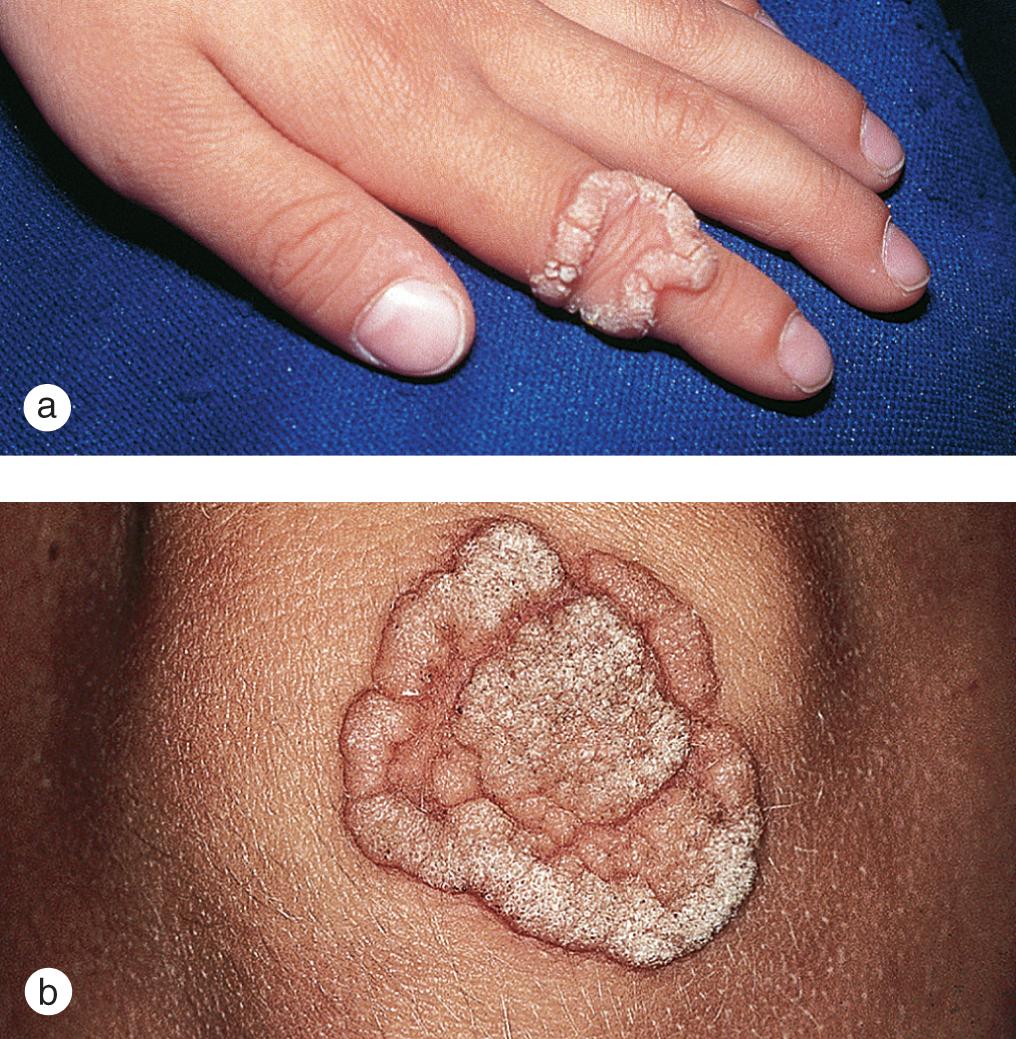
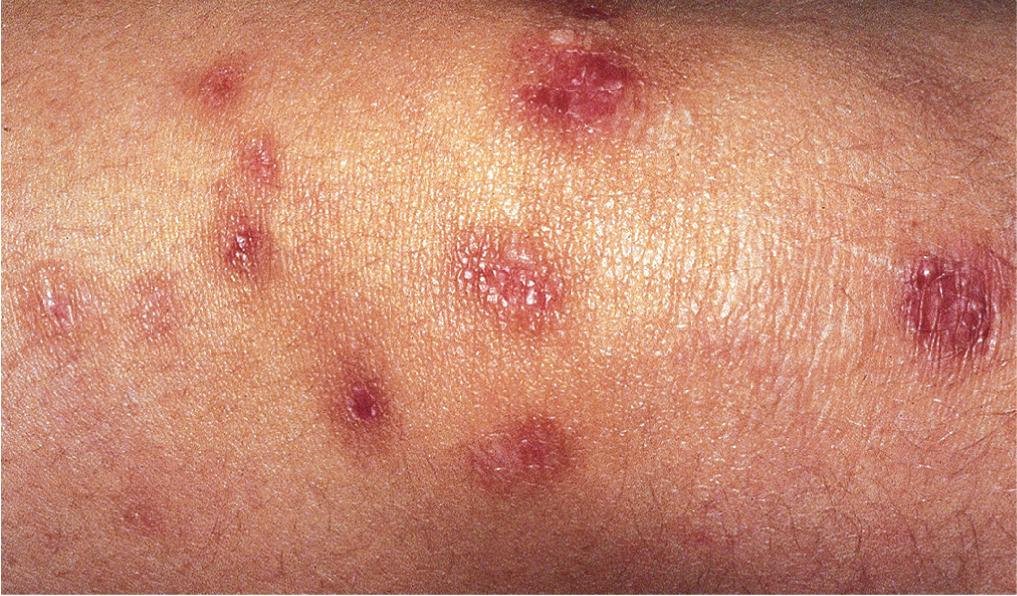
Large warts in the diaper area may cause itching, burning, bleeding, and secondary bacterial infection. Although not approved for use in children, judicious home application of topical imiquimod cream and podophyllotoxin gel or solution are safe and effective in symptomatic cases. Scissors excision with electrocautery and carbon dioxide laser ablation may be effective in recalcitrant cases. However, painful destructive measures can only be performed with deep sedation or general anesthetic. As with common warts, most anogenital warts in normal hosts will regress without treatment over 3–5 years.
Several innocent epidermal growths are often confused with warts. Epidermal nevi can have a verrucous appearance but are distinguished from viral warts by their linear configuration and lack of punctate hemorrhages. Heel-stick calcinosis can be mistaken for warts but have a chalky-white chalky appearance and classic location along the posterolateral aspect of the heel of the foot. Dermatosis papulosa nigra (DPN) describes a variant of seborrheic keratosis that appears in about a third of black individuals ( Fig. 5.10 ). Although seborrheic keratoses usually do not erupt until middle age, small, brown, warty DPN typically begins to develop during adolescence in a symmetric, malar distribution on the face. The neck and upper trunk may also be involved. Although DPN is of no medical consequence, irritated or unsightly lesions may be snipped, frozen, cauterized, or gently lasered after the application of a topical anesthetic. Patients must be warned about the risk of postinflammatory pigmentary changes after treatment. Another type of innocent epidermal lesion, pearly penile papule, is often diagnosed as warts. Uniform, 1–3 mm diameter papules ring the corona at the base of the glans penis. Pearly penile papules, which appear in up to one-third of men by adolescence, and vulvar vestibular papules are asymptomatic and probably represent a normal variant. No treatment is required.
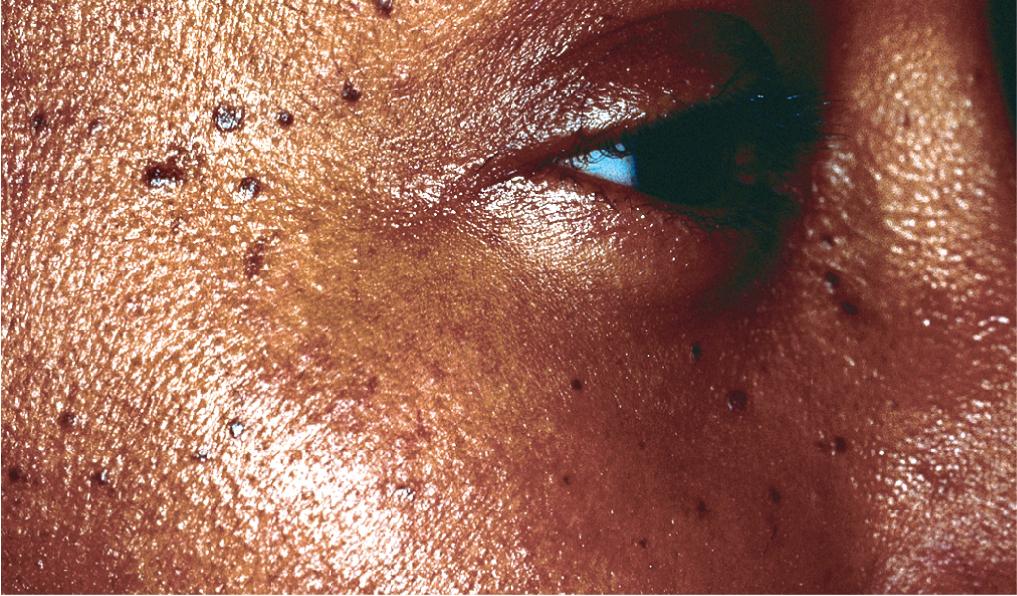
Molluscum contagiosum, caused by a large DNA poxvirus, is characterized by sharply circumscribed single or multiple, superficial, pearly, dome-shaped papules ( Fig. 5.11 ). They usually start as grouped, pinpoint papules and increase in size to 3–5 mm in diameter. Many lesions have umbilicated centers, which are best seen with a hand lens (dermatoscope, otoscope). Older lesions often appear crusted and lose their classic shiny, creamy appearance. Molluscum may leave behind subtle atrophic scars. Molluscum is endemic in young children, in whom involvement of the trunk, axillae, face, and diaper area is common. Lesions are spread by scratching and frequently appear in a linear arrangement ( Fig. 5.11 c). In teenagers and adults, molluscum occurs frequently in the genital area as a sexually transmitted disease ( Fig. 5.12 ) and diffusely in immunocompromised hosts.
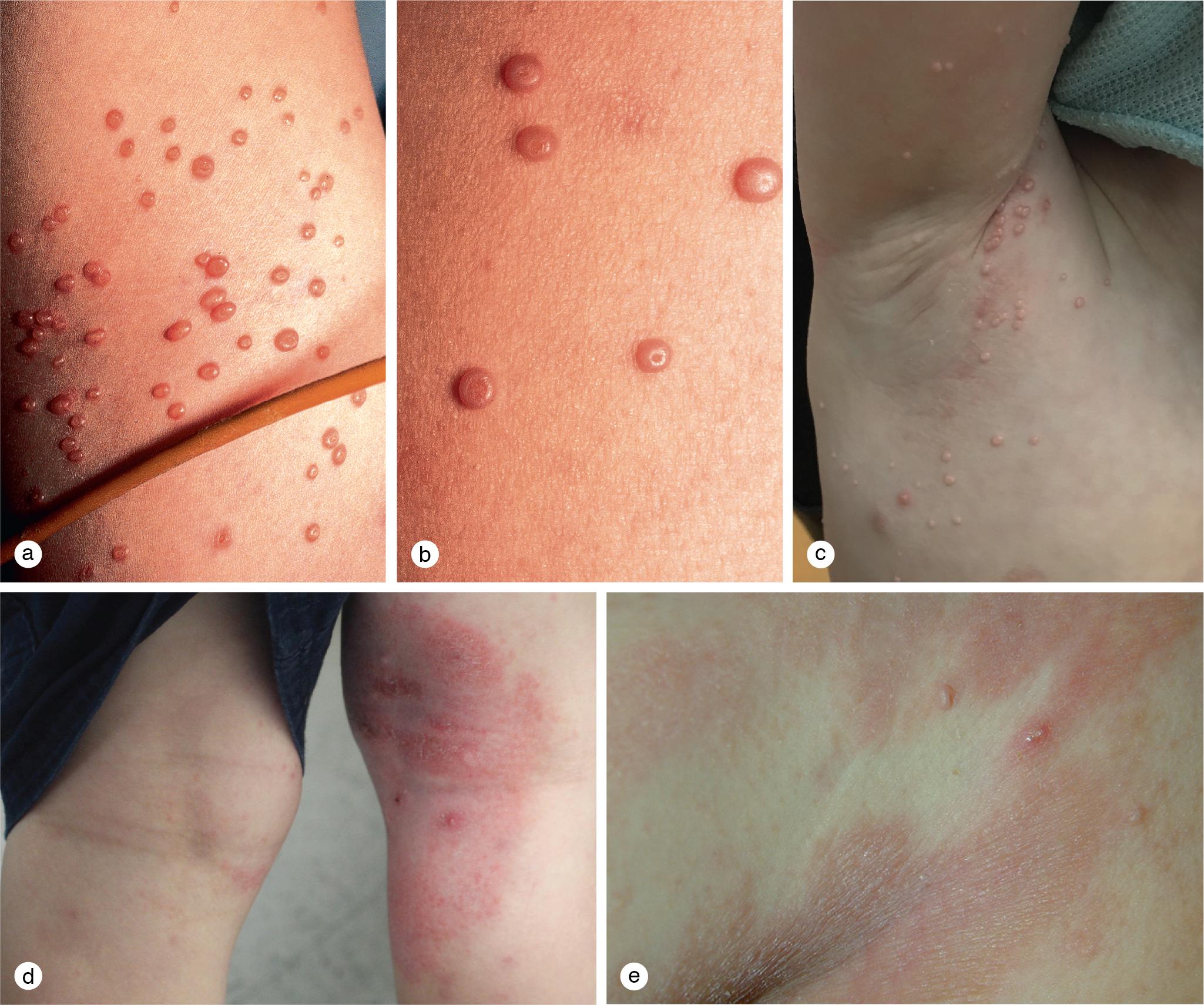
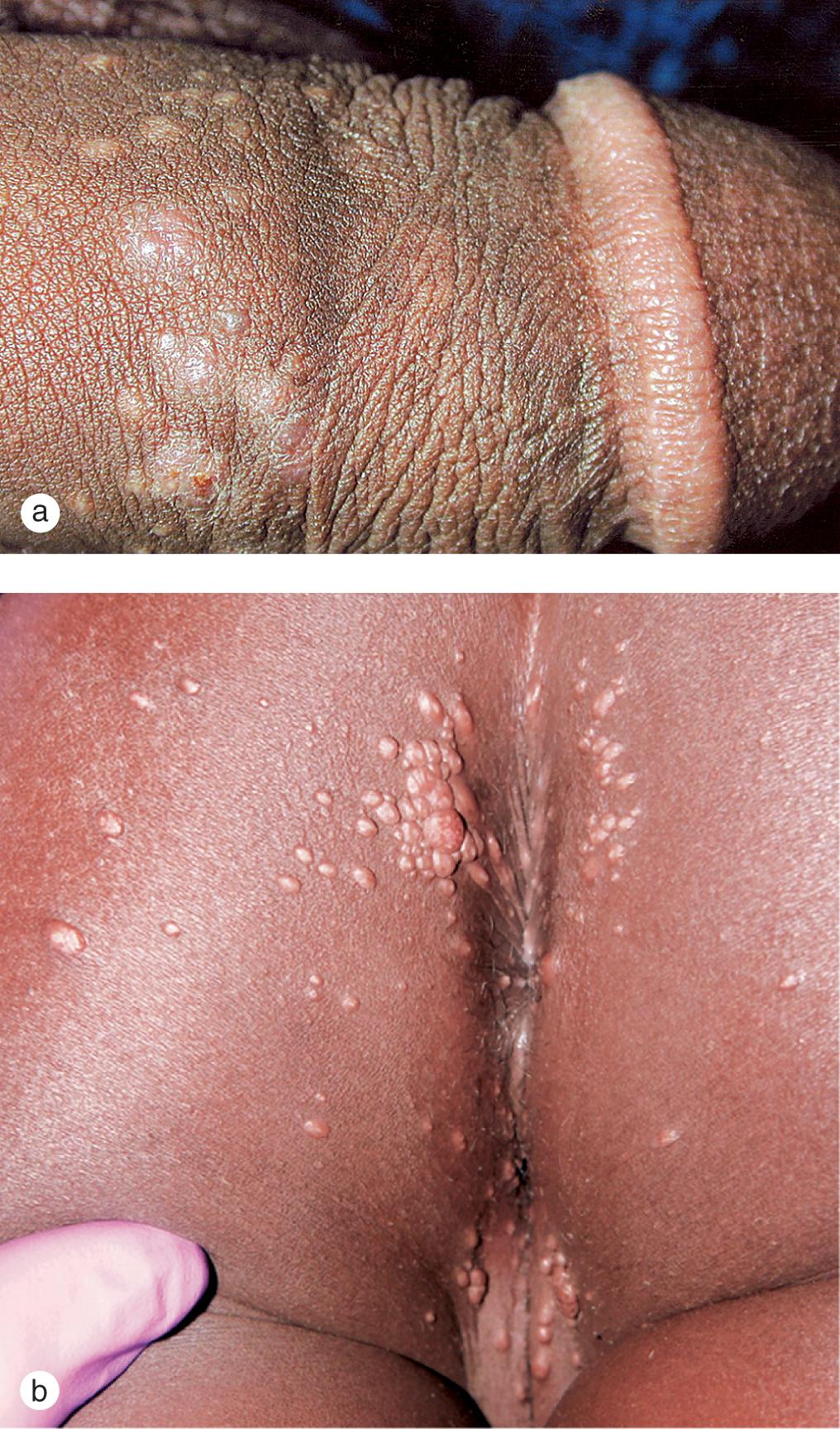
A white, cheesy core can be expressed from the center of the papule for microscopic examination, which reveals the typical molluscum bodies. Curettage and destruction of lesions by curetting their cores or by application of a blistering agent (cantharidin) and plastic tape may be curative of individual lesions. However, recurrences and the development of new papules are common, and most cases in normal hosts undergo spontaneous remission within 6 months to 2 years of diagnosis. Consequently, treatment is usually directed against symptomatic lesions only. Moreover, meta-analyses have not shown that any treatment is superior to placebo.
Bacterial superinfection may be treated with appropriate topical or oral antibiotics. The development of scaly, red eczematous rings around old papules, sometimes termed molluscum dermatitis, may herald the onset of a delayed hypersensitivity or “id” reaction and resolution of the infection ( Fig. 5.11 e). As in children with warts, patients with widespread, recalcitrant molluscum should be screened for congenital and acquired immunodeficiency.
Basal cell carcinoma (BCC) presents as a non-healing, pearly, reddish-gray to brown papule or plaque with a central dell or crust and peripheral telangiectasias ( Fig. 5.13 ). Although BCC occurs primarily in middle age and the elderly, the tumor is being recognized with increasing frequency in adolescents and young adults, particularly in fair-skinned individuals in sunny climates and with increased tanning bed use. The risk of developing BCC has been clearly linked to ultraviolet light exposure, and most lesions appear on sun-exposed sites, such as the face, ears, neck, and upper trunk. An indolent, superficial malignancy, uncomplicated BCC responds readily to electrodesiccation and curettage or simple excision. However, neglected lesions may become locally destructive and invade deep soft tissues, bone, and dura. Protection from excessive sun exposure, aggressive use of sunscreens, and careful skin surveillance should reduce the risk from BCC.
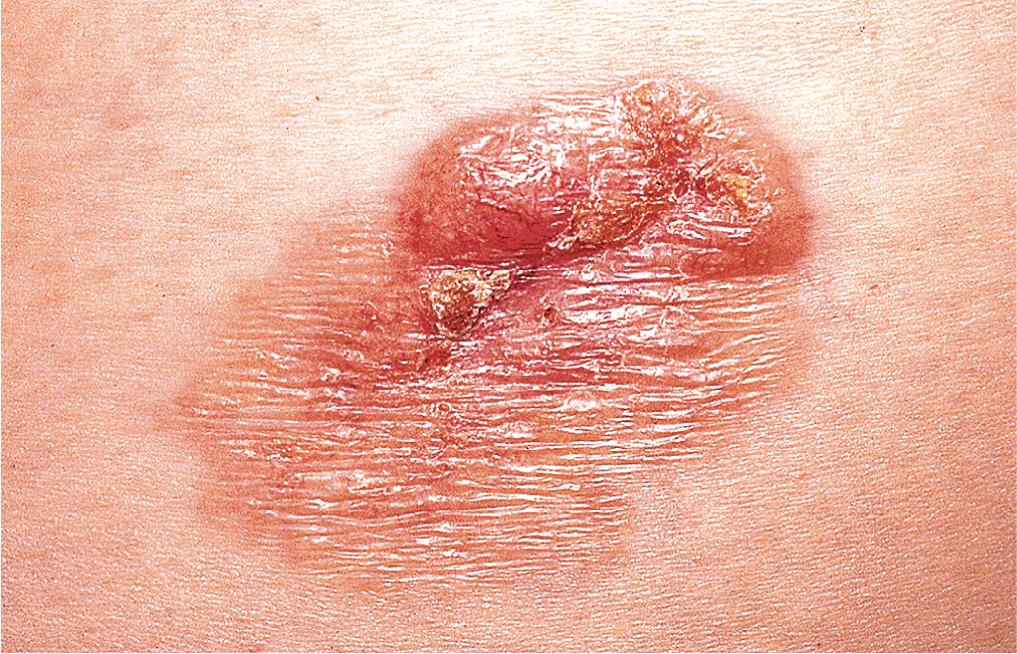
When BCC is diagnosed in sun-protected areas or in children, the practitioner must search for predisposing factors, such as radiation or arsenic exposure, a pre-existing nevus sebaceous or scar, or a hereditary condition such as xeroderma pigmentosum and basal cell nevus syndrome. In basal cell nevus syndrome, an autosomal-dominant disorder, numerous basal cell nevi are noted on the trunk, scalp, face, and extremities during the first decade ( Fig. 5.14 ). Unlike classic BCCs, they often resemble milia or melanocytic nevi early in presentation. In time, many of these lesions begin to enlarge and ulcerate and develop into progressive BCCs. Other stigmata include macrocephaly, frontal bossing, coarse facial features, palmar and plantar pits, jaw cysts, calcification of the falx cerebri, ovarian fibromas, and fused ribs. Early diagnosis and removal of enlarging BCCs reduces the need for more extensive and disfiguring surgery.
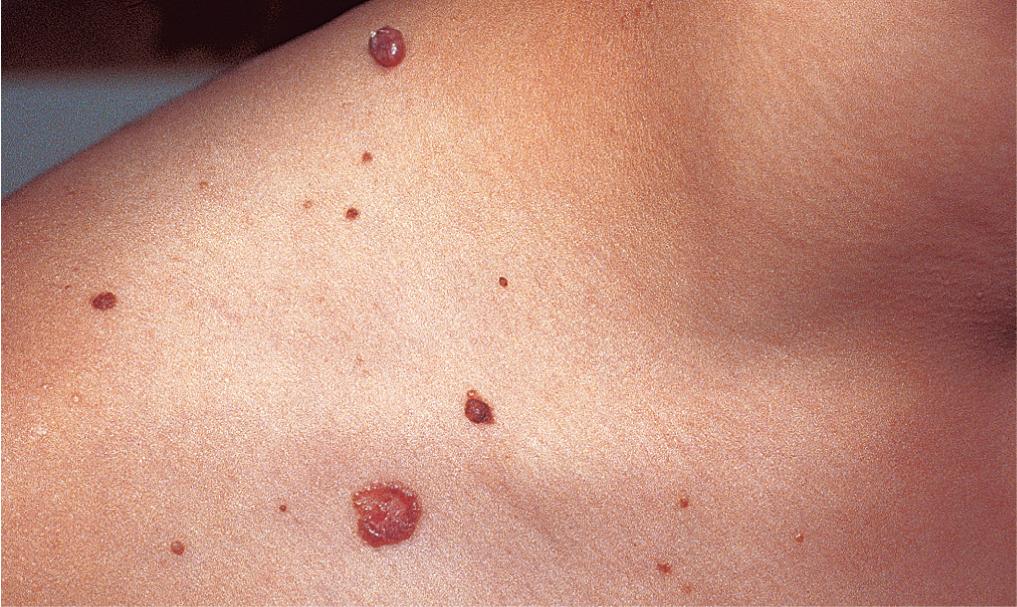
In children, BCC may be confused with warts, molluscum contagiosum, seborrheic keratoses, pigmented nevi, and other epidermal and superficial dermal growths. It should be considered in any slowly progressive, crusted, or ulcerated plaque, particularly if risk factors are present.
When fully evolved, granuloma annulare is an annular eruption histologically characterized by dermal infiltration of lymphocytes and histiocytes around altered collagen ( Fig. 5.15 a–d). The lesion begins as a firm papule or nodule, which gradually expands peripherally to form a ring 1–4 cm in diameter. Multiple rings may overlap to form large, annular plaques. In some cases, the rings are broken up into segments. The overlying epidermis is usually intact and has the same color as adjacent skin. However, it may be slightly red or hyperpigmented. Most lesions are asymptomatic, although a few are reported to be mildly pruritic. Granuloma annulare most commonly erupts on the extensor surfaces of the lower legs, feet, fingers, and hands, but other areas may be involved.
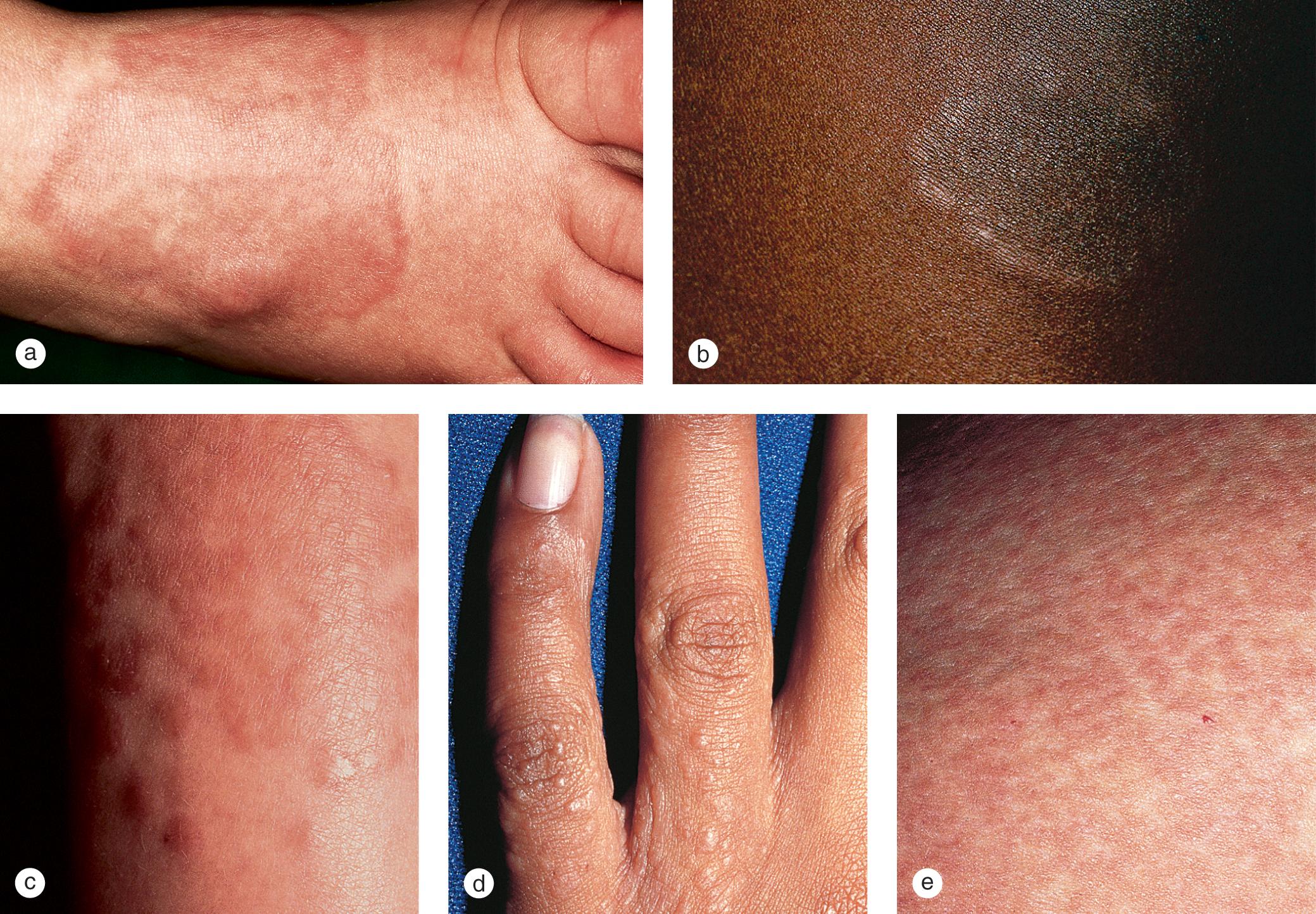
Over months to years, old plaques and papules regress while new lesions appear. Eventually, granuloma annulare resolves without treatment. The origin is unclear, but some lesions may be associated with insect-bite reactions or other antecedent trauma. The presence of an infectious trigger and/or aberrant immune regulation has been suggested as well. In adults, granuloma annulare, especially multiple eruptive lesions, have appeared in association with hyperlipidemia and diabetes mellitus ( Fig. 5.15 e). This is not the case in children.
Granuloma annulare is most commonly confused with tinea corporis or ringworm. However, the thickened, indurated character of the ring and lack of epidermal changes, such as scale, vesicles, or pustules, enable clinical distinction. A deep dermal or subcutaneous variant of granuloma annulare may be mistaken for rheumatoid nodules seen in rheumatic fever and other connective tissue disorders ( Fig. 5.16 ). These lesions are referred to as subcutaneous granuloma annulare and pseudorheumatoid nodules. Practitioners should avoid the latter term because the subcutaneous variant is not associated with local symptoms or systemic disease. Subcutaneous nodules occur most commonly on the extremities and scalp, where they are often fixed to the underlying periosteum. The diagnosis is often suggested by the presence of typical annular dermal plaques. When necessary, skin biopsies reveal changes similar to the more superficial lesions. Though treatment is often unsuccessful, options include topical corticosteroids, topical calcineurin inhibitors, intralesional corticosteroid injections, and cryotherapy. Skin biopsy may hasten resolution.

Neoplasms (benign and malignant) may arise from any structure in the skin. Although many tumors of the adnexal structures can only be differentiated by specific histopathology, some demonstrate distinctive clinical patterns.
Epidermal inclusion cysts (EICs) are slow-growing dermal or subcutaneous tumors that usually reach a size of 1–3 cm diameter and occur most commonly on the face, scalp, neck, and trunk ( Fig. 5.17 ). An overlying punctum may develop, and the lesions may drain a malodorous white to yellow keratinaceous material. In neonates, infants, and young children, they often present as a small shiny superficial white version of an EIC termed milia (see Fig. 2.18 a,b), most commonly on the face of neonates. They may be acquired after acute and chronic cutaneous injury, such as abrasions, surgery, and recurrent blistering in epidermolysis bullosa (see Fig. 2.52 ). Although milia often resolve without treatment, some remain indefinitely. Curettage or gentle puncture and expression with a comedone extractor or 22-gauge needle is usually curative.
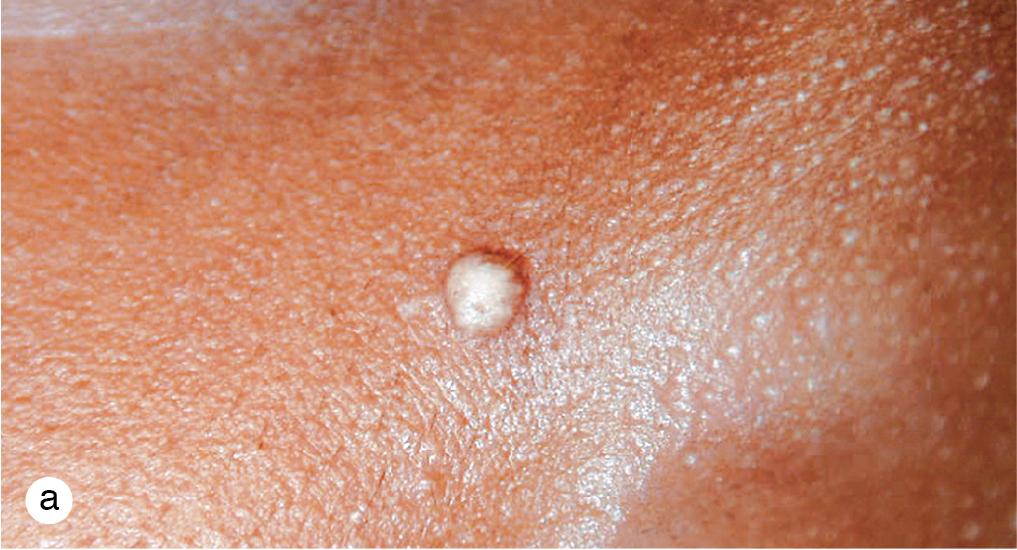
Small EICs can arise in neonates as median raphe cysts on the ventral surface of the penis and scrotum. EICs also occasionally develop on the palms and soles. These cysts account for a majority of cutaneous nodules found in children and may be present at birth or appear anytime in childhood. Although they are usually associated with hair follicles, EICs may arise from the epithelium of any adnexal structure. Primary lesions represent a keratinizing type of benign tumor. Other cysts occur as a response to trauma or inflammation such as in nodulocystic acne (see Fig. 8.23 c).
Histologically, EICs consist of epidermal-lined sacs, which arise most commonly from the infundibular portion of the hair follicle. Rupture of the cyst and spillage of the epithelial debris contained within results in acute and chronic dermal inflammation. These lesions may become red and painful. Non-inflamed cysts can be readily excised. However, inflamed lesions may be settled down first with intralesional injections of corticosteroids and oral antibiotics before surgery is attempted.
Most ECs are solitary. When multiple lesions are present, the preceding injury or inflammatory process is usually apparent. In other cases, the development of multiple cysts suggests the diagnosis of Gardner syndrome or intestinal polyposis type III. In this autosomal-dominant syndrome, increasing numbers of cysts, especially on the face and scalp, are associated with large-bowel polyposis and a ∼100% risk of malignant degeneration, osteomatosis that involves the bones of the head, and desmoid tumors, particularly of the abdominal wall, as well as congenital hypertrophy of the retinal pigment epithelium that can be detected early in life on ophthalmologic examination. Members of affected families may be screened for mutations in the APC gene.
A number of other cystic tumors in the skin, including trichilemmal cysts, pilomatrixomas, vellus hair cysts, steatocystoma, and dermoid cysts, may be confused clinically with ECs.
Pilar or trichilemmal cysts may be clinically indistinguishable from ECs. However, they are less common than ECs, occur almost exclusively on the scalp, and appear as multiple lesions in a majority of patients. They may have a distinct shiny pink appearance on the scalp and are less likely to drain than EICs. Trichilemmal cysts tend to be inherited in an autosomal-dominant pattern. Histologically, these lesions can be differentiated from epidermal cysts by the absence of a granular layer and homogeneous, pink keratinous material with calcification, unlike the laminated, horny material seen in ECs.
Pilomatrixoma, or calcifying epithelioma of Malherbe, presents as a sharply demarcated, firm, deep-seated nodule covered by normal or tethered overlying skin ( Fig. 5.18 ). Superficial tumors develop a bluish-gray hue, and occasionally protuberant, red nodules are present. The “teeter totter” sign refers to elevation of the contralateral edge of the lesion upon application of pressure to one end. The “tent sign” refers to angular protrusion of the lesion above the skin. Lesions range in size from <1 cm to >3 cm diameter. Although pilomatrixomas may arise at any age, 40% appear before 10 years of age and over 50% by adolescence. These tumors often come to the attention of anxious patients or parents when rapid enlargement follows hematoma formation after trauma. They may intermittently become inflamed, which presents as pain and sudden increase in redness and size.
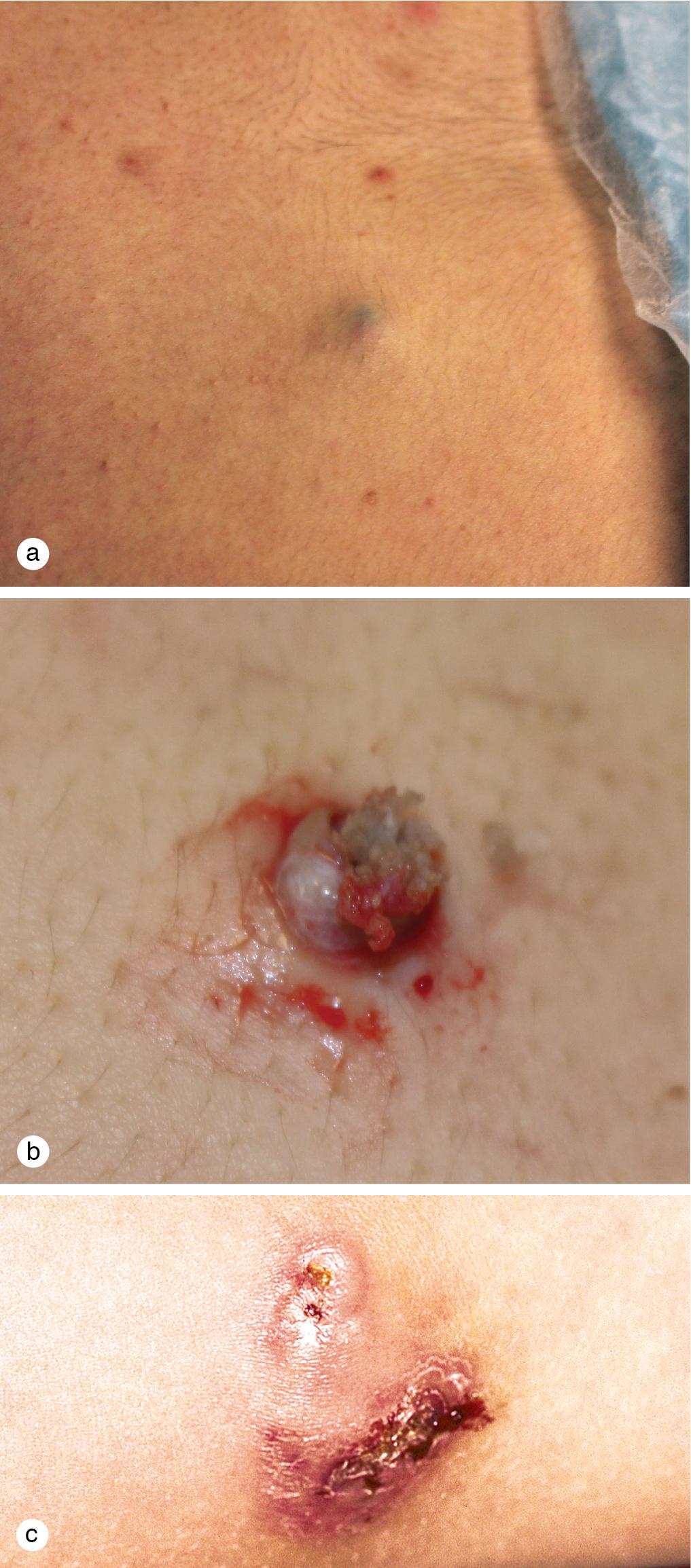
Pilomatrixomas occur most commonly on the face, scalp, upper arms, and upper trunk. They are usually solitary, but multiple lesions develop occasionally. Although most pilomatrixomas do not appear to be inherited, there are several reports of familial cases in an autosomal-dominant pattern and may be associated with certain genetic disorders including Gardner syndrome (usually EIC with pilomatrical differentiation), Turner syndrome, Myotonic dystrophy, and Rubinstein–Taybi.
Histologically, this well-demarcated, encapsulated tumor demonstrates a distinctive pattern with islands of basophilic and shadow epithelial cells. Eosinophilic foci of keratinization and basophilic deposits of calcification are scattered throughout.
Although pilomatrixomas are usually asymptomatic, rapid enlargement, ulceration, recurrent inflammation, or gradual progression to a large size may prompt surgical removal. They can usually be excised easily with local anesthetic.
Vellus hair cysts erupt as multiple, 1–2 mm diameter, follicular papules on the axillae, neck, chest, abdomen, and arm flexures of children and young adults ( Fig. 5.19 ). Some of the papules have an umbilicated center, suggestive of molluscum contagiosum, and impacted, lightly pigmented vellus hairs may poke out of the center. These asymptomatic lesions resolve over months to years without treatment. Familial cases with autosomal-dominant inheritance have been described. Topical retinoids may hasten the resolution of these innocent cysts, but irritation may limit therapy.
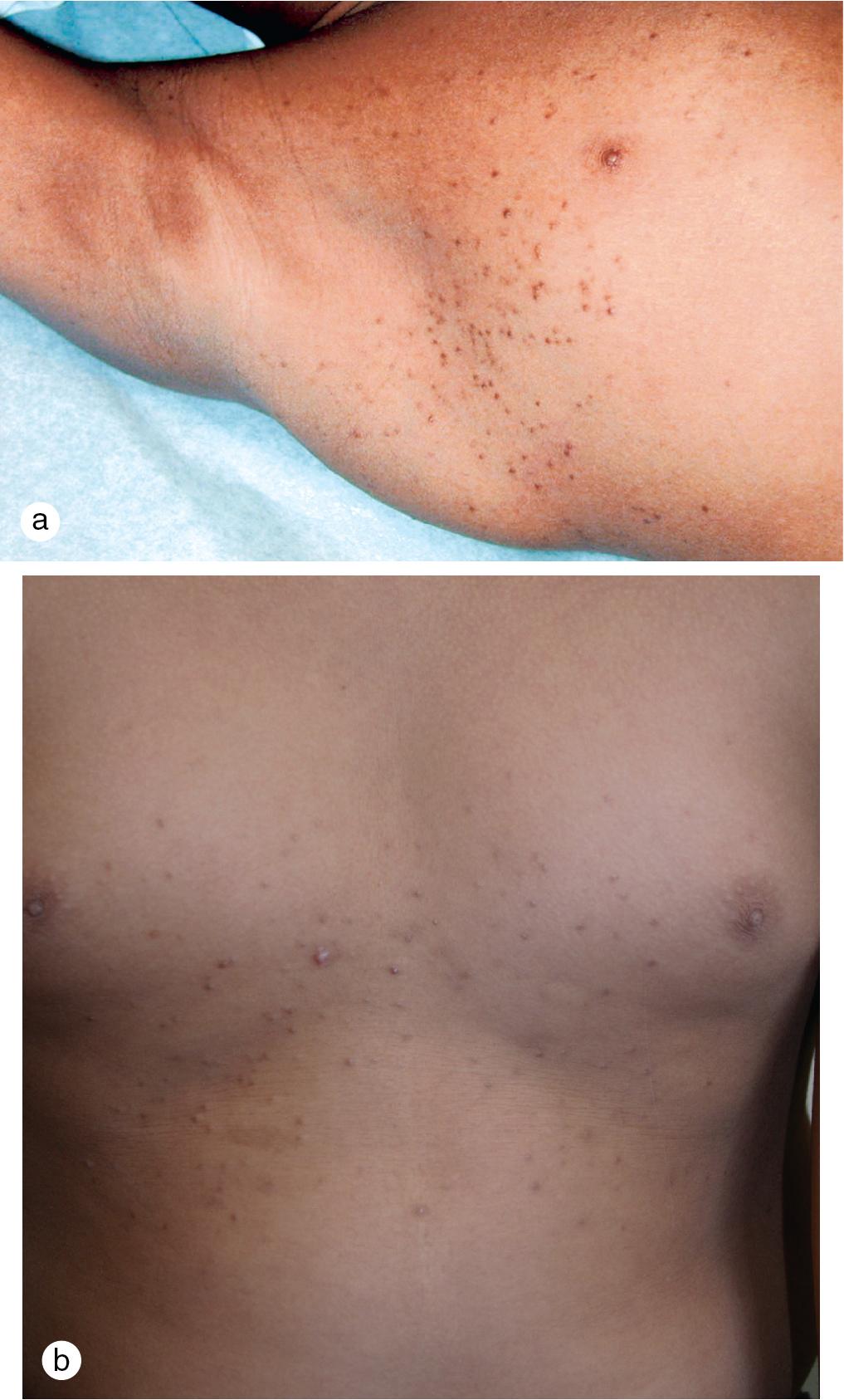
Become a Clinical Tree membership for Full access and enjoy Unlimited articles
If you are a member. Log in here